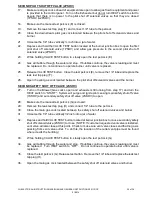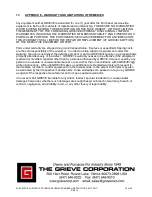
W:\ELECTRICAL\INSTRUCT\FURNACE\FURNACE GENERAL INSTRUCTIONS 2011.DOC
33 of 36
01/2014
35. ____ Number of safety shut off valve cycles should be estimated and safety shut off valves
replaced after 90% of lifetime cycles have been reached. Cycle estimate can be made by
multiplying number of years of service by 260 days per year (5 day work week) by number of
times furnace is turned on and off daily.
36. ____ Pilot and main burner light easily.
37. ____ Main flame blue with yellow tips.
38. ____ Flame rod clean and positioned correctly.
39. ____ Gas pressure set at pressure shown on nameplate. Setting is ________________
40. ____ Control valve linkage tight and operates smoothly over full range of travel.
SAFETY SWITCHES
41. ____ Disconnect both air tubes at each air flow switch to make sure furnace heat is shut down on
air flow switch deactivation.
42. ____ Check that purge timer is set for purge time shown on Safety Design Form and Caution
nameplate installed adjacent to purge timer. Confirm purge time by checking against clock
and record. ___________
TEMPERATURE CONTROLS
:
43. ____ Heat furnace to operating temperature and check temperature controller calibration.
44 ____
compare temperature controller indication and excess temperature limit interlock indication
to confirm they are similar.
45. ____ Disconnect one side of thermocouple connection to confirm upscale break protection is
operating on main temperature controller and excess temperature limit interlock.
46. ____ To check excess temperature limit interlock function, heat furnace above excess
temperature limit interlock setpoint. Make sure excess temperature limit interlock shuts
down heat by opening main contactor (or SCR power controller) and separate contactors on
electric furnaces and closes all gas valves on gas furnace.
47 ____
Excess temperature limit interlock is set no higher than 50°F above maximum operating
temperature of furnace.
LOCATION
:
48. ____ No changes in the furnace area have created a hazardous condition such as external heat,
vibration, mechanical hazard or corrosive environment.
49. ____ No process change has resulted in flammable liquids or explosive vapors or dust cloud being
stored or produced in vicinity of furnace.
50. ____ Portable fire extinguishers in the area have been inspected.
51. ____ Fire suppression systems, such as a sprinkler system, have been inspected.
52. ____ Sprinkler heads in furnace and duct work have been inspected and cleaned.
TRAINING
53. ____ Review job function, furnace operation and emergency shutdown with operators and
supervisors.




































